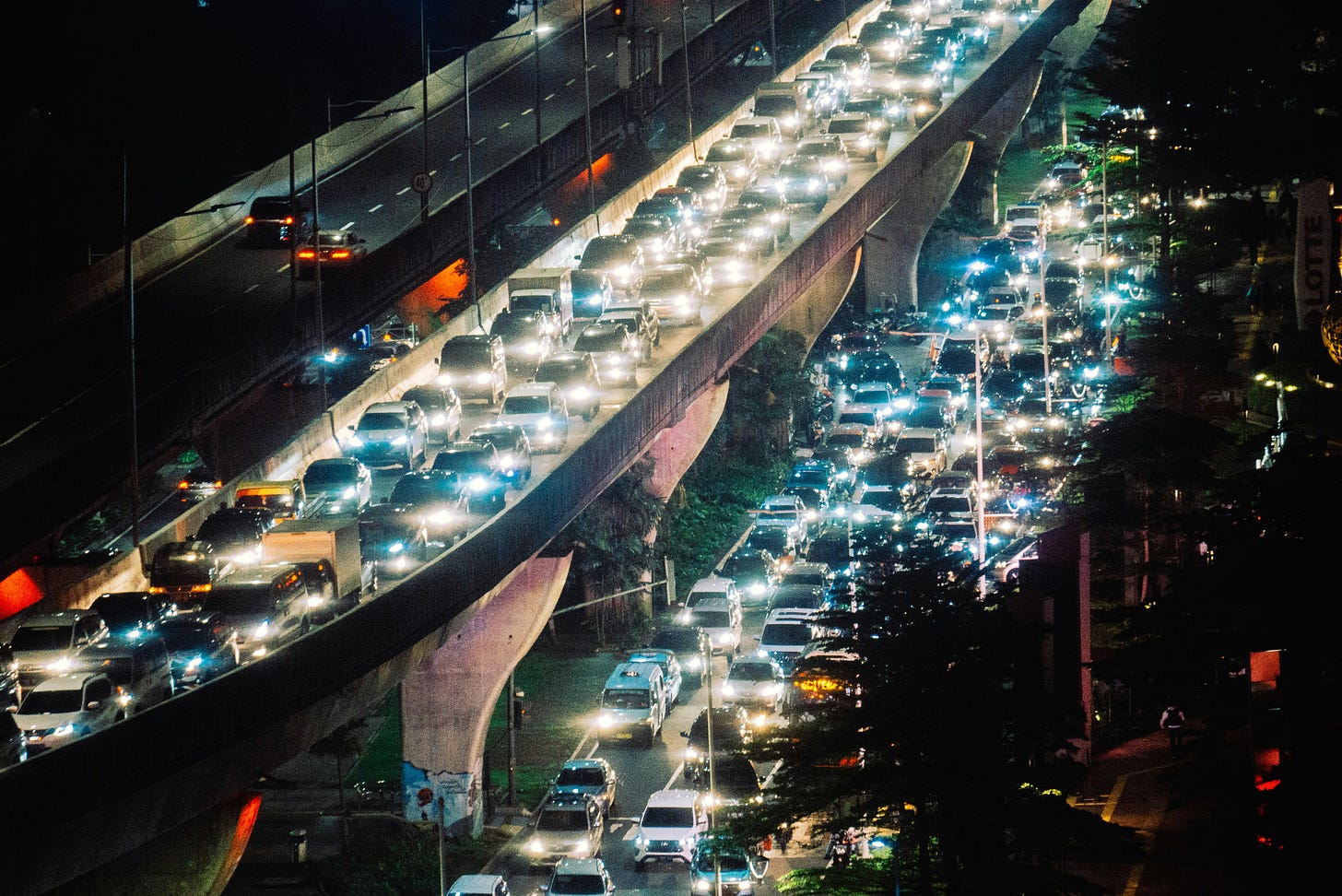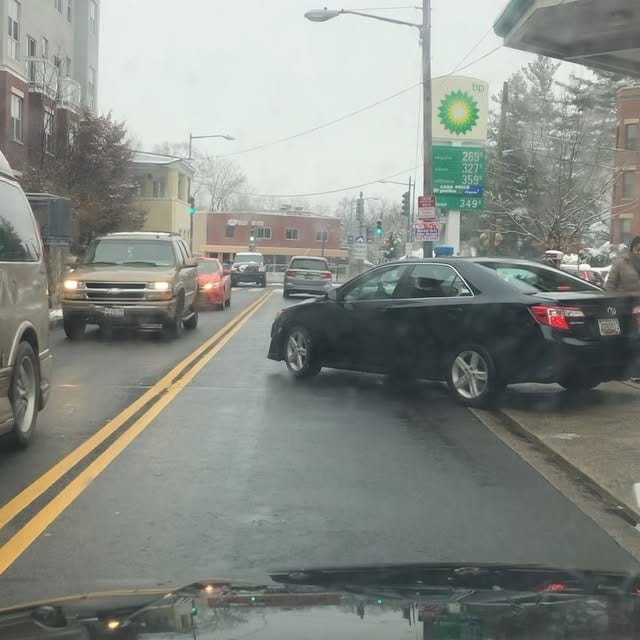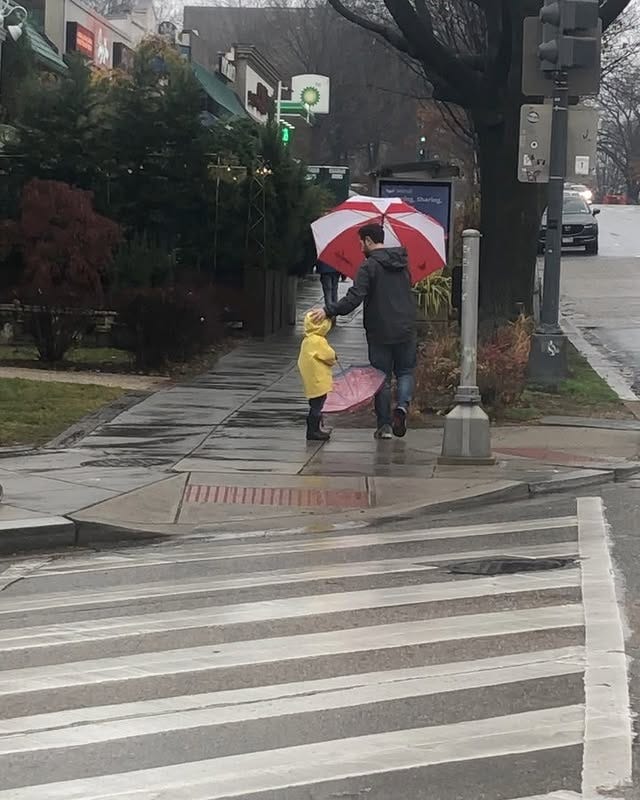photo by Marcel Ardivan
This series consists of provocations to stimulate your body’s deep instinct to learn.
Written instructions are provided to invite you to be the author of your own process.
The practices can be explored briefly as a way to simply create a new pattern in the flow of your day or at greater length to allow for deeper investigations of your patterns and potentials.
Initial postings will be available to all subscribers. Please consider becoming a paid subscriber. By doing so, you can help me to publish this series one day as a book.
Paid subscribers will also be able to access to audio instructions. Mixing guided audio with self-paced practice via text will yield you the most creative potential to find your own way.
Sense the infinite rhythms of traffic
While driving, your first responsibility is not to kill anyone (that includes you).
But you should be able to manage that and carry out the following experiment.
You can start by practicing only at red lights if that feels better. Later, you can practice when your car is in motion (and will likely enjoy it more). It’s even possible that this experiment will make you a safer driver.
In fact, “awareness” is a fairly complete description of the practice. To be more thorough, add the word “appreciation.” This is about paying attention to - and appreciating - an everyday phenomenon that most people ignore.
Cars on a highway can be like salmon swimming upstream or blood vessels swimming through veins. The movement of each vehicle must be coordinated with its neighbors so everyone can achieve safe forward motion and arrive to their destination.
Within a city, by necessity, the movement is more staccato.
Stop. Go. Slow. Fast. Brake. Accelerate. Signal. Turn. Honk. Change lanes. React. Repeat.
Rhythmic patterns unfold through time and space, making music as they go. Thanks to rearview mirrors, vision is extended to more of the world. Sound is everywhere.
At the stop light, you wait to make a left turn, your foot poised to step on the gas. The turn signal click-clocks metrically. A car horn honks somewhere out of sight.
Crosswalkers criss-cross in front of your eyes, a second layer of visual rhythm just beyond the dance of your windshield wipers with the rain.
A third layer is the traffic criss-crossing in the intersection from right to left and left to right (which cars are closer to you depends on which country you’re in).
With all of these possibilities, where do your eyes go? Which sounds capture your attention?
Your heart beats many times as you breathe in and many times as you breathe out. Your eyes look here, then there, then over there. Your inner voice makes commentary.
It’s a very ordinary moment in traffic. And it’s exquisitely polyrhythmic.
Silent rhythms tap a beat on your eyeballs. A flashing light. A bird flying overhead. Invisible rhythms echo in your ears. Both kinds of rhythms dance together.
The rhythm of your car engine and the bumps in the road reverberate through your car seat, your skin and your bones. If you place two fingers on the side of your throat, you can bring your heartbeat into the foreground along with your breath.
Your blood cells and lungs dance in traffic too.
How many rhythms can you hold in your awareness?
Discussion:
Learning is easiest when you feel safe. Being in a car isn’t as safe as being at home, but it’s a place you spend a lot of time. Expanding options in this circumstance has inherent value. It helps you stay present, and being present helps keep you safe.
James Carse, author of Finite And Infinite Games, writes:
“We persuade ourselves that, comfortably seated behind the wheels of our autos, shielded from every unpleasant change of weather, and raising or lowering our foot an inch or two, we have actually traveled somewhere.”
This non-traveling form of travel dulls our senses in a particular way:
“We do not move from our point of departure, but with our point of departure. To be moved from our living room by an automobile whose upholstered seats differ scarcely at all from those in our living rooms, to an airport waiting room and then to the airplane where we are provided the same sort of furniture, is to have taken our origin with us; it is to have left home without leaving home. To be at home everywhere is to neutralize space.”
The primal duty of your perception is to tell you where you are in space. If anything, driving a car should heighten your desire for greater spatial awareness.
(Self-driving cars dull this desire.)
Life is movement. Movement produces sights, sounds, and sensations - rhythms. Most people prefer “music” to “traffic”, but they are actually the same thing.
This experiment works best without piping in other sounds on your radio or phone, but if you do, notice how those reminders of ‘home’ fix the frame of your perception to rhythms that aren’t responsive to the shifting music of the environment.
Some old Instagram posts of mine related to this experiment (including the captions):










